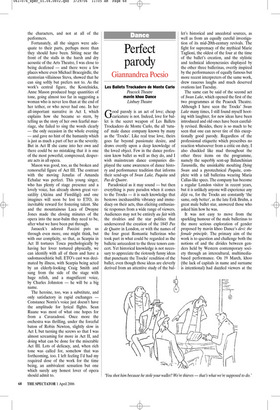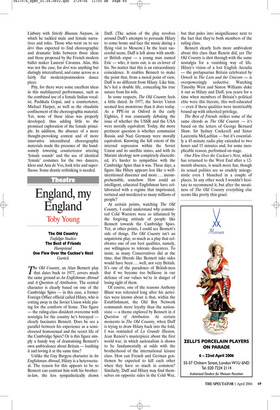Perfect parody
Giannandrea Poesio
Les Ballets Trockadero de Monte Carlo Peacock Theatre mavin khoo Dance Linbury Theatre Good parody is an act of love; cheap caricature is not. Indeed, love for ballet is the secret weapon of Les Ballets Trockadero de Monte Carlo, the all ‘tutued’ male dance company known by many as the ‘Trocks’. Like real true love, theirs goes far beyond passionate desire, and draws overtly upon a deep knowledge of the loved object. Few in the dance profession know ballet as well as they do, and I wish mainstream dance companies displayed the same awareness of dance history and performance tradition that informs their send-ups of Swan Lake, Paquita and Pas de Quatre.
Paradoxical as it may sound — but then everything is pure paradox when it comes to the Trocks — it is such knowledge that bestows inexhaustible vibrancy and immediacy on their acts, thus eliciting enthusiastic responses from a wide range of viewers. Audiences may not be entirely au fait with the rivalries and the star politics that underscored the creation of the 1845 Pas de Quatre in London, or with the names of the four great Romantic ballerinas who took part in what could be regarded as the balletic antecedent to the three tenors concert. Yet historical knowledge is not necessary to appreciate the riotously funny ideas that punctuate the Trocks’ rendition of the ballet, even though those ideas are cleverly derived from an attentive study of the bal let’s historical and anecdotal sources, as well as from an equally careful investigation of its mid-20th-century revivals. The fight for supremacy of the mythical Marie Taglioni, the oldest of the four at the time of the ballet’s creation, and the stylistic and technical idiosyncrasies displayed by the other three ballerinas, overtly inspired by the performances of equally famous but more recent interpreters of the same work, drew raucous laughs and much deserved ovations last Tuesday.
The same can be said of the second act of Swan Lake, which opened the first of the two programmes at the Peacock Theatre. Although I have seen the Trocks’ Swan Lake many times, I still found myself hooting with laughter, for new ideas have been introduced and old ones have been carefully revised. Besides, there is so much to be seen that one can never tire of this exceptionally good parody. Regardless of the professional etiquette which prescribes no reaction whatsoever from a critic on duty, I also chuckled like mad throughout the other three items on the programme, namely the superbly sent-up Balanchinian Tarantella, the unsinkable moulting Dying Swan and a pyrotechnical Paquita, complete with a tall ballerina wearing Maria Callas-like specs. The company has become a regular London visitor in recent years, but it is unlikely anyone will experience any déjà vu, for the Trocks are constantly ‘the same, only better’, as the late Erik Bruhn, a great male ballet star, answered those who asked him how he was.
It was not easy to move from the sparkling humour of the male ballerinas to the more serious exploration of gender proposed by mavin khoo Dance’s devi: the female principle. The primary aim of the work is to question and challenge both the notions of and the divides between genders held by Western contemporary society through an intercultural, multimediabased performance. On 19 March, khoo (the lack of capitals in name and surname is intentional) had dazzled viewers at the Linbury with Strictly Bharata Natyam, in which he tackled male and female narratives and roles. Those who went on to see devi thus expected to find choreographic and dramatic links between those ideas and those proposed by the French modern ballet maker Laurent Cavanna. Alas, this was not the case, for devi was anything but daringly intercultural, and came across as a fairly flat modern/postmodern dance piece.
Pity, for there were some excellent ideas in this multilayered performance, such as the combined use of a female Indian vocalist, Pushkala Gopal, and a countertenor, Michael Harper, as well as the ritualistic confinement of the choreographic material. Yet, none of these ideas was properly developed, thus adding little to the promised exploration of the female principle. In addition, the absence of a more thought-provoking context and of more innovative intercultural choreographic materials made the presence of the handsomely towering countertenor uttering ‘female sounds’ and the use of identical ‘female’ costumes for the two dancers, khoo and Ann de Vos, look trite and superfluous. Some drastic rethinking is needed.



























































































 Previous page
Previous page